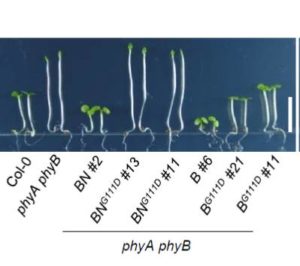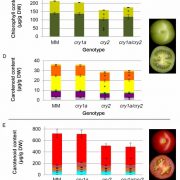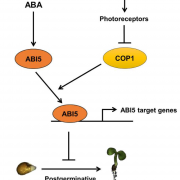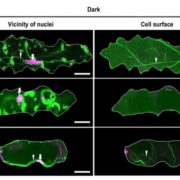Phytochrome B mutants discern distinct roles of PIF degradation and sequestration (Plant Cell)
 The interaction between phytochromes and phytochrome-interacting factors (PIFs) is key to light signaling. Both sequestration and degradation of PIFs occurs, and Park et al. have explored the relative contributions of these two PIF fates to the light response. They studied two mutants, one with a point mutation in the N-end (phyBG111D), and one with a C-terminal truncation accompanied by a point mutation (phyB999G767R), each retaining one of the two functions. The two modified phyBs show similar responses to constant red light. The mutation that promotes PIF degradation normally but is deficient in PIF sequestration, phyBG111D, shows a more normal response to longer-scale, circadian cycles, whereas the other, which is deficient in promoting PIF degradation but sequesters PIF normally, shows a more normal response to short light pulses or sunflecks. These results suggest that PIF sequestration is more relevant to rapid, short-term light responses, whereas PIF degradation may be more important for slower, longer-scale responses. (Summary by Mary Williams) Plant Cell 10.1105/tpc.17.00913
The interaction between phytochromes and phytochrome-interacting factors (PIFs) is key to light signaling. Both sequestration and degradation of PIFs occurs, and Park et al. have explored the relative contributions of these two PIF fates to the light response. They studied two mutants, one with a point mutation in the N-end (phyBG111D), and one with a C-terminal truncation accompanied by a point mutation (phyB999G767R), each retaining one of the two functions. The two modified phyBs show similar responses to constant red light. The mutation that promotes PIF degradation normally but is deficient in PIF sequestration, phyBG111D, shows a more normal response to longer-scale, circadian cycles, whereas the other, which is deficient in promoting PIF degradation but sequesters PIF normally, shows a more normal response to short light pulses or sunflecks. These results suggest that PIF sequestration is more relevant to rapid, short-term light responses, whereas PIF degradation may be more important for slower, longer-scale responses. (Summary by Mary Williams) Plant Cell 10.1105/tpc.17.00913









